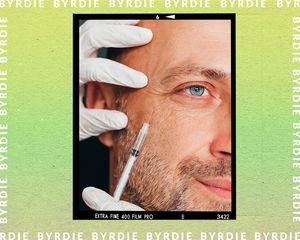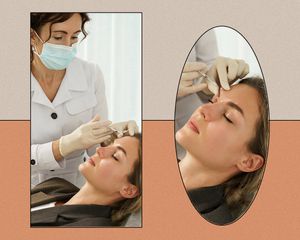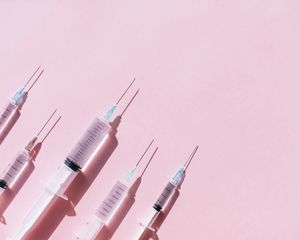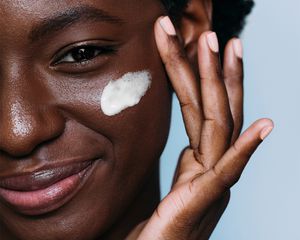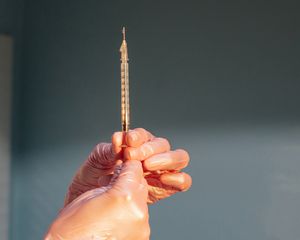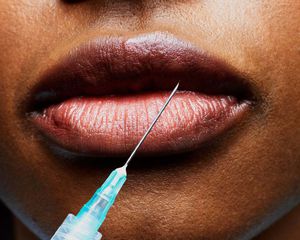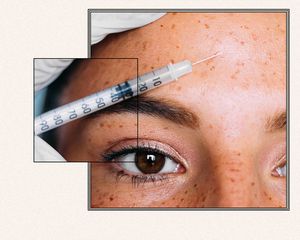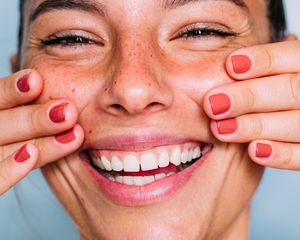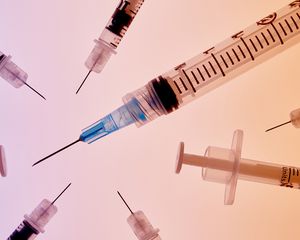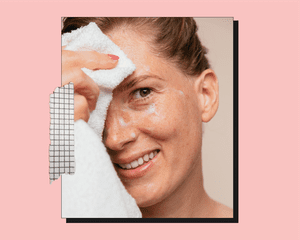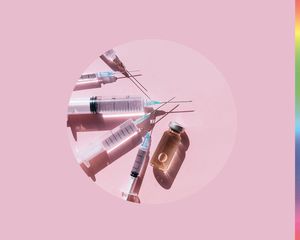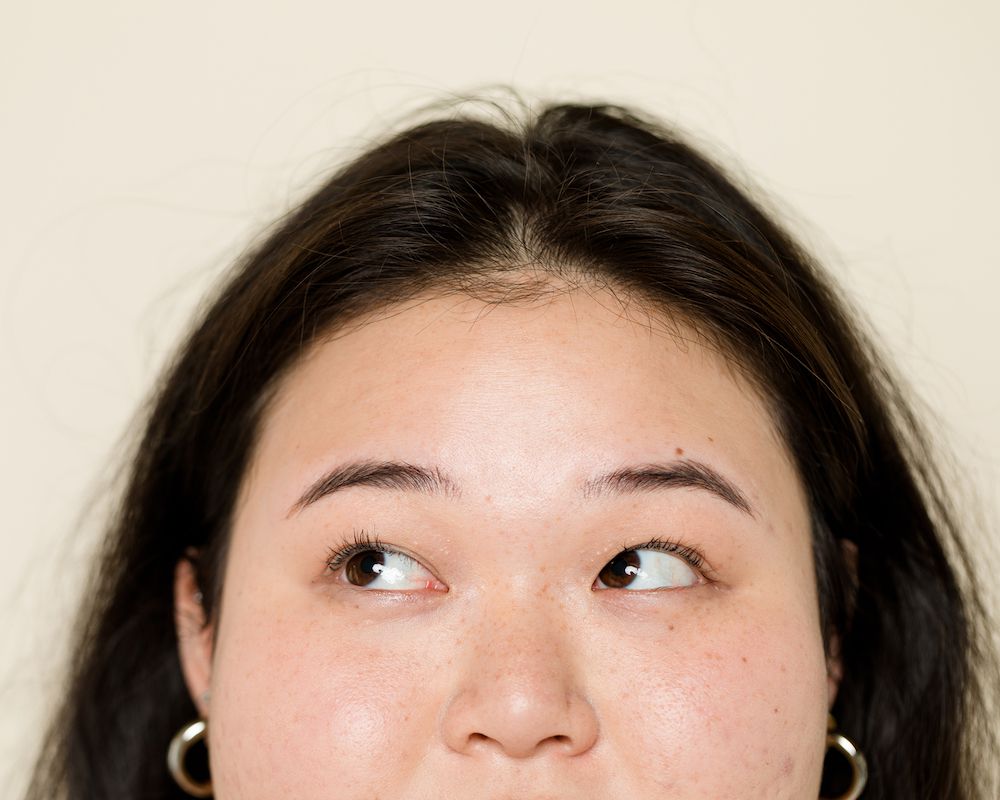
McKinsey Jordan / Stocksy
As we age, it's perfectly natural to develop fine lines and wrinkles underneath your eyes, along your forehead, in-between your eyebrows, and around the nose and mouth. These are all areas of frequent expression and a sign of a life filled with joy and surprise—so those little lines are nothing to be ashamed of.
With that being said, there's also nothing wrong with coming to the decision to soften your wrinkles with a treatment like Botox. By now, you probably know that Botox—when performed by a board-certified dermatologist—is incredibly effective at reversing the signs of aging in almost any area of the face. But perhaps you've also heard the rumor that getting Botox in your 20s and 30s can actually stop wrinkles in their tracks in a treatment frequently referred to as "preventative" Botox.
So what is preventative botox, and can it actually prevent wrinkles from forming when you receive the treatment early on? Ahead, we've tapped board-certified dermatologists Dr. Konstantin Vasyukevich, Dr. Azza Halim, Dr. Ben Lee, and Dr. Paul Jarrod Frank to find out everything you need to know about preventative botox.
Meet the Expert
- Dr. Konstantin Vasyukevich is a double board-certified facial plastic surgeon based in New York City.
- Dr. Azza Halim is a board-certified physician/anesthesiologist with practices in Illinois and Florida.
- Dr. Ben Lee is a leading expert in body contouring and pro-aging surgeries.
- Dr. Paul Jarrod Frank is a celebrity cosmetic dermatologist based in New York City.
What Is Preventative Botox?
Botox is one of the most utilized treatments for visible signs of aging (like wrinkles). Typically, people start to consider Botox once their fine lines and wrinkles begin to deepen and become more noticeable. Meanwhile, preventative Botox refers to the idea that you can receive Botox injections before the onset of wrinkles to prevent them from forming in the first place. The idea is that if you receive Botox before you begin to see wrinkles, the Botox will weaken the facial muscles that cause the skin to wrinkle, thus significantly slowing the formation and deepening of wrinkles.
“Preventative Botox is not for everyone," explains Dr. Vasyukevich. "People with strong, overactive muscles of facial expression (i.e., people with 'expressive' faces) are the ones that would benefit the most from this type of injection. These patients would have a nearly smooth forehead at rest, but very deep lines when asked to raise the eyebrows or frown.”
Benefits of Preventative Botox
- Prevents deep static lines from developing
- Can prevent wrinkles altogether
- Saves on high Botox costs in the future
As with many other things, wrinkles are easier to prevent than to remove. So if you do think you'll want to treat your wrinkles in the future, it's more effective (and less expensive) to get ahead of them than to try and eliminate them retroactively. Deep wrinkles require more units of Botox and typically more frequent visits to the dermatologist to see the desired effects.
When Is the Best Time to Get Preventative Botox?
There isn't an exact science as to when you should start getting Botox. "You can start when you notice wrinkles that bother you—which could be as early as someone in their early 20s or up to someone in their early 40s. There are many factors that play into this, including age, genetics and skin type," says Dr. Frank. Consistent sunscreen use from a young age is also a huge factor.
Unsurprisingly, in cities like Los Angeles, Botox is more common at a younger age. “Most people start to think about Botox treatments when they start to notice early wrinkles in the upper third of their face, usually in their mid-to-late 30s to early 40s," says Dr. Lee. "Increasingly, more and more people are beginning Botox treatments before they notice visible wrinkles, in the hopes that they never appear. In our Los Angeles practice, a sizable portion of our neuromodulator patients are in their mid-20s." Frank recommends waiting until you're a little older to start Botox as chronic weakening of the muscles over decades of time can change the anatomy of the face.
How to Prepare for Preventative Botox
While neuromodulator treatments don’t take much preparation, it’s important not to take any over-the-counter pain medications such as ibuprofen or aspirin for a week prior to the injection, as they may increase your chances of bruising. Also, make sure to avoid drinking alcohol for at least 24 hours prior.
What to Expect During a Preventative Botox Treatment
After discussing your treatment goals with your provider, you will mutually agree upon an amount of Botox to inject. Tiny needles are then used for injection and placed strategically and precisely in specific muscles—typiically around the forehead, between the brows, and in the outside corners of the eyes. The entire process is done in just a few minutes.
As far as treatments go, preventative Botox is relatively painless according to most patients, as numbing cream and other pain prevention methods are typically used to minimize the discomfort. An ice pack will be applied afterward to minimize the chance of bruising. You'll be able to resume normal activities within two hours of the injection.
Preventative Botox vs. Baby Botox
Preventative Botox and Baby Botox are completely different injection strategies. Preventative Botox is for people who have not developed significant wrinkles, whereas Baby Botox is for those who have developed the wrinkles already and want to get rid of them slowly over time rather than with one treatment. “Baby Botox could be used as a preventative treatment, but it may not be the most effective or convenient way to maintain a youthful look,” says Vasyukevich.
Potential Side Effects
Botox is considered to be a safe treatment when performed by experienced hands (i.e., a board-certified dermatologist). However, just like with regular Botox injections, Vasyukevich explains that there is a possibility of minor asymmetry (typically easily corrected), droopy eyelids, or double vision.
Discuss your individual concerns and goals with your doctor before any treatment, as starting too young and using the product too aggressively for decades can exacerbate the natural weakening of the muscles. And as with any injectable, avoid medi-spas and opt for a board-certified injection like a dermatologist or facial plastic surgeon.
The Cost
Botox prices can vary, and the treatment is not covered by insurance. “One should never look for bargains when having aesthetic treatments,” warns Dr. Halim. "It's your face, so it simply isn't worth the risk." In the hands of an experienced provider, Botox runs about $9-$12 dollars per unit or more. Expect to spend $300-$600 for the typical treatment areas (forehead, glabella, and eyes). Vasyukevich recommends repeating the injections every six months to a year.
Aftercare
There is very little one needs to do after a Botox injection. Halim advises staying upright for the first four hours after treatment to minimize any spread of product to areas the treatment was not intended for. Also, stay away from facials or lying face down for the first 48-72 hours, as these can lead to undesirable results. “Regular use of sunscreen, good hydration, and appropriate skin moisturizers will be helpful in prolonging the effects of Botox,” says Vasyukevich.
The Final Takeaway
Aesthetic treatments are a deeply personal choice, and one that should only be made between you and your physician. While Botox is becoming more normalized as more and more people realize how natural-looking, common, and safe this neuromodulator is, that doesn't mean Botox is "mandatory" just because you're turning a certain age. But if faint fine lines or wrinkles are starting to bother you, preventative Botox can be incredibly effective at softening those lines and preventing deeper wrinkles from forming. Just remember that it's not a one-and-done. For optimal results, you'll have to keep up with your preventative treatments every six months or so, which can be costly. Always see a board-certified injector for Botox; when you book a consultation, they can tell you if you're a candidate for treatment, how frequently you'll need to come in, and how much money you should expect to set aside for your treatments.


